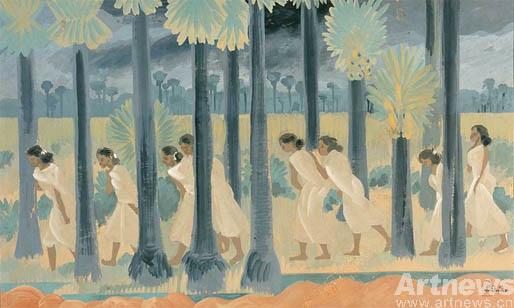|
 Nandalal Bose,新的云,紙上蛋彩畫,1937年
Nandalal Bose,新的云,紙上蛋彩畫,1937年
圣地亞哥訊 圣地亞哥美術館首次組織除亞洲以外的巡回展,全面展出印度現代藝術之父Nandalal Bose(1882–1966)的戲劇節目。“印度旋律”將有近100幅Bose 的精品繪畫,有多種風格和媒介。展示了他與圣雄甘地的親密關系和對印度非暴力的運動的成功貢獻。
??????? 該展覽的組織者通過與印度政府和新德里國立現代畫廊的通力合作,探索了印度在從英國殖民地到一個獨立的國家決定性轉型時期變化。這個展覽也是第一次允許Bose 的作品在亞洲以外展出,展示了Bose 在一個獨立的印度下為發展視覺印度現代新藝術的基礎與方式。
??????? Nandalal Bose 1882年出生在印度北部比哈爾,1905年開始了他的藝術生涯,他是許多藝術家參與甘地領導的非暴力運動和為尋找印度擺脫殖民統治和西方化理想中的一員。1919年,Bose 成為諾貝爾得主泰戈爾在孟加拉鄉村建立的綜合大學藝術學校的第一個主管,在那里,傳統的印度技巧超過了英式教育。
San Diego Museum of Art Presents Rhythms of India: The Art of Nandalal Bose (1882-1966)
SAN DIEGO, CA.-The San Diego Museum of Art has organized the first comprehensive traveling exhibition outside of Asia to survey the expansive repertoire of Nandalal Bose (1882–1966), the father of modern art in India. Rhythms of India features close to 100 of Bose’s finest paintings, which are executed in a variety of styles and media. It also reveals how Bose contributed to the success of India’s non-violent struggle for independence from colonial rule through his close association with Mahatma Gandhi.
Organized through an unprecedented collaboration with the government of India and the National Gallery of Modern Art, New Delhi, this groundbreaking exhibition explores the crucial period of India’s transition from a British colony to an independent nation through the lens of the country’s premier artist of the time. The exhibition also marks the first time that a survey of Bose’s work has been permitted to leave Asia. The works on view reveal the way Bose contributed to the development of a new Indian art form and laid the foundation for modern visual culture in independent India.
Nandalal Bose was born in Bihar, India, in 1882. At the beginning of his career in 1905, he was one of many artists and visionaries who sought to revive the spirituality and cultural authenticity of Indian art after 50 years of colonial rule and westernization. In 1919, Bose became the first director of the art school at the new university founded by Nobel laureate Rabindranath Tagore in rural Bengal. Here, traditional Indian teaching methods were favored over British-style education.
|

